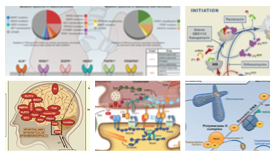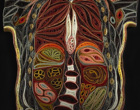
Volume 151, Issue 6
On the cover: In its natural environment, Drosophila melanogaster feeds on yeasts that grow on sugar-rich substrates such as fermenting fruit. Fruits, however, also harbor toxic microbes, and flies need to distinguish those microbes that are safe and nutritious from the harmful ones. In this issue, Stensmyr et al. (pp. 1345–1357) demonstrate that flies detect toxic molds by sensing a volatile compound called geosmin, which exclusively triggers a dedicated signaling pathway in the flies' olfactory system. This circuit, upon activation, causes innate aversion and also prevents egg laying and feeding. Cover concept by Rakel and Marcus Stensmyr. Clay modeling and photo by Marcus Stensmyr.
Announcement
- Cell Press has been chosen by the International Society for Stem Cell Research (ISSCR) to publish its new open access journal Stem Cell Reports, which will launch in June 2013.

- » Microbiome and host health
- » Mitochondria
- » Genes, circuits, and behavior
- » Immunometabolism
- » Cancer epigenomics
- » Human evolution
- » Stem cells for modeling and treating disease
- Click here to find out about these topics and our Cell Symposia series.
Coming December 21st
- » Mutational hot spots in human genome
- » Focal adhesions in durotaxis
- » Reprogramming refractory cells
Recent Comments
- Tamir Tuller discusses Ingolia, Weissman et al. 2011:
- Jonathan Weissman responds:
- Join the conversation:
Click "add/view comments" on an article's summary page.
Editorial Openings
Most-Read Papers
- What are the most-downloaded papers from the Cell website in the past 30 days?
Connect with the Editors on Facebook
New!
Cell 2011 Impact Factor: 32.403
Source: © Thomson Reuters Journal Citation Reports (2012)

In this show, Parasites and Vectors, get a close up view of these organisms that cause or transmit diseases such as malaria.

View more slideshows.
Cell Picture Show thanks our sponsor.
Cell Press celebrates the achievements of Cell and Cell Stem Cell Editorial Board member Shinya Yamanaka and Sir John B. Gurdon, the recipients of the 2012 Nobel Prize in Physiology or Medicine.
Read the award winners' research published in Cell Press journals FREE including Dr. Yamanaka's groundbreaking 2006 paper in Cell: "Induction of Pluripotent Stem Cells from Mouse Embryonic and Adult Fibroblast Cultures by Defined Factors".
Listen to more PaperClips.
Andrea J. Berman and Thomas R. Cech
Mollie B. Woodworth, Luciano Custo Greig, Arnold R. Kriegstein, and Jeffrey D. Macklis
Brian Ell and Yibin Kang
View all of our SnapShots.

Introducing the new SnapShot archive: With >120 SnapShots—sorted and categorized—from chromatin remodelers and autophagy
to cancer and autism.

Cell SnapShot Archive thanks our sponsor.
SnapShot
SnapShots present up-to-date tables of nomenclature and glossaries, full signaling pathways, and schematic diagrams of cellular processes. See the full list of SnapShots.
mTORC1 Signaling at the Lysosomal Surface
Liron Bar-Peled and David M. Sabatini
NEW! Spotlight on China:
Informational Supplement to Immunity
 Cell Press is proud to bring you Spotlight on China. This informational supplement captures the ongoing progress in immunology research in China.
Cell Press is proud to bring you Spotlight on China. This informational supplement captures the ongoing progress in immunology research in China.
Access your complimentary copy today!
Free access made possible by:
The Chinese Society for Immunology, CNBG, GlaxoSmithKline, Sino Biological, Inc.
Job Seekers: View the latest Jobs in Life Science on the all-new Cell Career Network!
Employers/Recruiters: Post your vacancies and learn more about our various recruitment advertising solutions. Click here for more information.
Guide to Publishing with Cell Press
Watch four Cell Press editors answer questions from three early-career scientists about preparing, submitting, and publishing an article in a Cell Press journal.
Issue Highlights

SPECIAL FOCUS
Organelles as Signaling Platforms
A special focus in Leading Edge on the roles played by organelles as platforms for signaling pathways from innate immunity to growth and metabolism.
Perspectives from Kagan on endosomes and innate immune signaling and Brodsky on ER-associated degradation. Review by Andrews et al. on Bcl2 signaling at the mitochondria. SnapShot by Bar-Peled and Sabatini on mTORC1 activity at the lysosomal surface.

BENCHMARKS
As the awards ceremony for the 2012 Nobel Prizes approaches, we take a closer look at the discoveries celebrated in this year's awards for GPCR structures and cellular reprogramming.

BOOK REVIEW
Cell Press President Lynne Herndon reviews the new edition of The Double Helix by Jim Watson, now annotated and illustrated by Alexander Gann and Jan Witkowski.

RESEARCH
The loss of SIRT6 promotes the metabolic reprogramming of cancer cells by increasing aerobic glycolysis and ribosome biosynthesis.
Online Now
Architecture of the Atg17 Complex as a Scaffold for Autophagosome Biogenesis
Ragusa, Hurley, and colleagues
Cell PaperFlick
|
|
Featured Article free
|
This PaperClip features the musical theme, "the phoenix - 1st sonata for helena in style of 303" (the phoenix) / CC BY 3.0. Have 5 minutes to learn about cutting-edge research in Cell? Browse our PaperClip archive. |
Leading Edge Featured Article free
|
Annotated Classic: The iPS Breakthrough Paper |
Cell Podcast
|
In this month's Cell Podcast, we learn:
»
How stem cells from the testes may preserve fertility in young male cancer patients, with Kyle Orwig (0:00) (Cell Stem Cell) You can listen directly by clicking on the player above. For a complete list of Cell Press podcasts, you can subscribe via iTunes or view the archive. |
Cell PaperClip from November 9th
|
This PaperClip features the musical theme, "the phoenix - 1st sonata for helena in style of 303" (the phoenix) / CC BY 3.0. Have 5 minutes to learn about cutting-edge research in Cell? Browse our PaperClip archive. |




































